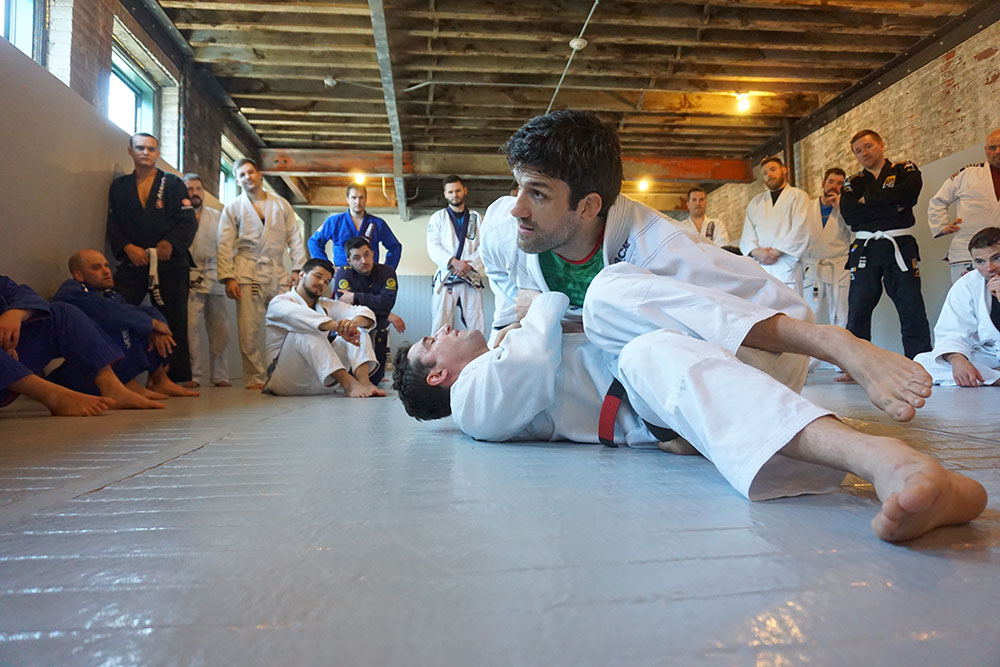
Tips on how to learn Brazilian Jiu Jitsu better
 We just hosted my first jiu jitsu teacher, Rolles Gracie for a seminar at Stout Training Pittsburgh – team Renzo Gracie. The way Rolles structured his seminar reminded me of something really important about learning jiu jitsu (and probably any other new skill or concept). What Rolles reminded me is that depth of learning is more important than volume, that simple concepts learned in a practical way can increase creativity, and that learning can be cumulative starting from the micro level and increasing to the macro level.
We just hosted my first jiu jitsu teacher, Rolles Gracie for a seminar at Stout Training Pittsburgh – team Renzo Gracie. The way Rolles structured his seminar reminded me of something really important about learning jiu jitsu (and probably any other new skill or concept). What Rolles reminded me is that depth of learning is more important than volume, that simple concepts learned in a practical way can increase creativity, and that learning can be cumulative starting from the micro level and increasing to the macro level.
Let me explain by giving a quick summary of how the seminar was taught. Rolles spent the whole seminar as he said in his own words “teaching one move”. It was a guard pass. Within this guard pass we saw concepts applied such as putting pressure on the opponent, being comfortable while making the opponent uncomfortable, proper posture, hip control, gripping, base, cross corner control of opponents body, and phycology of passing the guard. That’s a lot of concepts and they don’t just apply to the technique we worked on. For example gripping strategy of chewing up your grip and noticing which grip to release first can be applied to almost all gi jiu jitsu positions and many positions without the gi. Because we saw this concept applied, and experienced it I now believe I can apply it creatively to other techniques.
He built each technique from the previous technique and used examples from the branches of the techniques to illustrate macro principals like hip control. Rolles said that his main goal for a seminar is to have students be able to apply what is taught at the end of the seminar. In order to do this it is important to get deep into one concept. Seminars only last a couple of hours. Most peoples’ attention spans are even less. By using the time to dive into a concept and build off of one technical structure we can actually apply a rather complex group of strategy, technique, and options. Pavel Ksatsouline (world renowned strength trainer www.strengthfirst.com) uses the phrase “an inch wide and a mile deep” to describe this type of thinking. Josh Waitzkin (chest prodigy, BJJ black belt, and elite performance coach) calls it “making smaller circles”. I recommend a podcast by Tim Ferriss “A chess Prodigy on Mastering Martial Arts, Chess, and Life”. Get it on Tim Ferriss Show podcast or download from iTunes: https://itunes.apple.com/us/podcast/the-tim-ferriss-show/id863897795?mt=2. He does a great job articulating the learning method Rolles used in his seminar. It is about 25 minutes total.
One of the problems is the volume of material out there. Information has made it harder to focus and go deep into simple concepts. When I was younger (before youtube and flow wrestling.com ) I would seek out and get my hands on a few gems of Russian wrestling instruction that was starting to come out of the soviet union. I would also get home camcorder recordings of competitions such as the Ivan Yerigin tournament in Russia. These few example were so special to me I actually watched some of the VHS tapes until they wore out. Now there is so much footage of all kinds for MMA, Jiu Jitsu, wrestling and other combat sports that it is hard to focus on any one thing. I watch an instructional on a knee cut guard pass from Lucas Lepri, then I watch Victor Estima playing lapel guards against Keenan Cornelius in ADCC Pro. Then it’s on to Burroughs in the world cup wrestling. While it is great to have all this available It require more discipline to focus on “smaller circles”. Not only has video availability increased seminars and schools have increased as well. Jiu jitsu technique is so amazing for us aficionados that there is temptation to be a collector of techniques. You can’t know everything in a deep way. Even the best say this. I remember Roger Gracie talking to me a a small group about inverted guards. To paraphrase he said: I understand them but I don’t use them. I think it is important to know these positions.” Roger then explained when the guard player is in a bad position and when he is in a good position in inverted guard. What I interpreted from this was that he understands as a professional and teacher the positions but because he doesn’t use them his time isn’t spent going as deep as he does with, say the closed guard.
I suggest trying to focus more. I’m going to try to do this in the next couple of days, while learning jiu jitsu. If you did the Rolles Gracie seminar you got a direct experience of this. That is why seminars are so important. They give you EXPERIENCE, not just passive witnessing. In our youth jiu jitsu programs this month our “Powerful Word” (Robyn Silverman -www.powerfulwords.com) of the month was Gratitude. I’m am grateful to have teachers like Rolles to continue to guide my jiu jitsu. I’m also grateful to have students and teammates who help us bring guys like Rolles Gracie and all of our other great seminar guests to Pittsburgh to help us to really learn Brazilian Jiu Jitsu in a deeper way.
-Warren
Here is a little bonus clip. I know, we’re adding to the volume of information but this is a quick gem of a really common position and very simple ![]()